Annual Report 2002 Komax – Success through ... - Komax Group
Annual Report 2002 Komax – Success through ... - Komax Group
Annual Report 2002 Komax – Success through ... - Komax Group
Create successful ePaper yourself
Turn your PDF publications into a flip-book with our unique Google optimized e-Paper software.
<strong>Annual</strong> <strong>Report</strong> <strong>2002</strong><br />
<strong>Komax</strong> <strong>–</strong> <strong>Success</strong> <strong>through</strong> innovation
About the illustrations<br />
We live in an age of innovation. Each achievement is<br />
constantly replaced by newer versions that are even<br />
faster, even more efficient, even better … and even<br />
more high tech. This also applies to the markets that<br />
are important for <strong>Komax</strong>. The ability to offer innovative<br />
solutions for new market requirements at the<br />
right time is a vital success factor. For this reason<br />
we invest substantial resources in development and<br />
engineering, and with success: <strong>Komax</strong> generates<br />
about 70% of its sales with products that are not<br />
more than two or three years old.<br />
General note<br />
For the sake of readability, the masculine pronoun is<br />
used <strong>through</strong>out this <strong>Report</strong> to include the feminine<br />
gender.
Contents<br />
Highlights __2<br />
<strong>Report</strong> of the Board of Directors __5<br />
China <strong>–</strong> the locomotive for growth in the future? __10<br />
<strong>2002</strong> <strong>–</strong> review of operations __14<br />
2003 <strong>–</strong> creating the basis for the future __22<br />
New connection technologies <strong>–</strong> the future has begun __26<br />
Glossary __32<br />
Corporate governance and<br />
financial report __Appendix
Highlights<br />
Net sales of the <strong>Komax</strong> <strong>Group</strong><br />
220<br />
200<br />
180<br />
160<br />
140<br />
120<br />
100<br />
80<br />
60<br />
40<br />
20<br />
0<br />
in CHFm 1998 1999 2000 2001 <strong>2002</strong><br />
Operating profit (EBIT) of the <strong>Komax</strong> <strong>Group</strong><br />
34<br />
32<br />
30<br />
28<br />
26<br />
24<br />
22<br />
20<br />
18<br />
16<br />
14<br />
12<br />
10<br />
8<br />
6<br />
4<br />
2<br />
0<br />
in CHFm<br />
2__<br />
142.0<br />
22.4<br />
183.7<br />
27.6<br />
211.6<br />
32.9<br />
196.9<br />
18.7<br />
191.5<br />
17.7<br />
1998 1999 2000 2001 <strong>2002</strong><br />
Key figures of the <strong>Komax</strong> <strong>Group</strong><br />
in CHFm <strong>2002</strong> 2001 +/- in % 2)<br />
Net sales 191.5 196.9 -2.7<br />
EBITDA 25.8 26.4 -2.3<br />
Operating profit (EBIT) 17.7 18.7 -5.4<br />
<strong>Group</strong> profit after tax (EAT) 13.2 13.9 -5.1<br />
Research & development 17.3 16.5 +4.8<br />
Free cash flow 3.7 -6.9 +153.0<br />
Investments in fixed assets 16.8 19.6 -14.7<br />
Net investments in participations 0.3 11.1 -97.3<br />
Net cash (+) / net indebtedness (-) -23.7 -26.9 -11.8<br />
Shareholders’ equity 126.2 118.8 +6.3<br />
Headcount (as of 31.12.) 680 698 -2.6<br />
Net sales per employee 0.282 0.276 +2.2<br />
Basic earnings per share CHF 4.23 4.47 -5.4<br />
Equity per share CHF 40.00 38.10 +5.0<br />
Dividend per share CHF <strong>–</strong> 1.00 <strong>–</strong><br />
Repayment of par value<br />
per share CHF 1.00 1) <strong>–</strong> <strong>–</strong><br />
Price high CHF 95.00 163.00 -41.7<br />
Price low CHF 39.50 59.00 -33.1<br />
1) Proposal of the Board of Directors of <strong>Komax</strong> Holding AG.<br />
2) Percentage change in the amount calculated in CHF 1,000.
<strong>Komax</strong> <strong>–</strong> <strong>Success</strong> <strong>through</strong> innovation<br />
Despite the difficult economic environment, the opportunities for growth in<br />
the markets that are important for <strong>Komax</strong> are better than ever. Driven by<br />
the growing demand for comfort and safety, which has led for one thing to<br />
an increasing number of electronic assemblies and for another to miniaturization<br />
of the components used and higher quality standards, more and<br />
more processes are being automated. At the same time, high productivity<br />
requirements and the use of new technologies such as fiber-optic cables<br />
or flat cables are putting pressure on manual processing.<br />
<strong>Komax</strong> is responding to these trends with quality<br />
and innovative solutions. In the past fiscal year the<br />
<strong>Group</strong> further strengthened its market position<br />
with a number of new products and by expanding<br />
its sales structures. This is creating the conditions<br />
needed to make greater use of existing market<br />
opportunities and to successfully deal with future<br />
challenges.<br />
__3
<strong>Report</strong> of the Board of Directors<br />
Dear Shareholders<br />
In the past fiscal year <strong>Komax</strong> once again made considerable<br />
progress in realizing its objectives. The <strong>Group</strong> has further<br />
expanded its market position by strengthening its presence in<br />
Asia and by launching new products. We also achieved<br />
better-than-average growth in system business in the wireprocessing<br />
sector.<br />
Melk M. Lehner (left), Chairman of the Board, and Leo Steiner,<br />
President & <strong>Group</strong> Chief Executive Officer.<br />
We accomplished this despite the deterioration in the<br />
economic climate in the markets that are important<br />
for <strong>Komax</strong>; the economic upswing that was generally<br />
hoped for in the third, and then in the fourth quarter<br />
of <strong>2002</strong> failed to materialize. Given these conditions<br />
we rate it as a success that sales and earnings <strong>–</strong><br />
after a weak second half in 2001 and first half of<br />
<strong>2002</strong> <strong>–</strong> showed a marked improvement in the second<br />
half of <strong>2002</strong>.<br />
Sales <strong>–</strong> up on previous year after adjustment<br />
for currency fluctuations<br />
Sales declined by 2.7% to CHF 191.5 million compared<br />
with the year-back period (previous year:<br />
CHF 196.9 million). This is attributable in the main to<br />
unfavorable exchange rates: in local currency terms<br />
the increase would have been 2.1%. Wire-processing<br />
system business grew at a disproportionately<br />
high rate; sales in Europe and North America doubled<br />
compared with the previous year, due in no small<br />
measure to innovative new solutions. Wire-processing<br />
machine business also developed satisfactorily<br />
in the USA and in Asia. By contrast, sales in Europe<br />
fell because of reluctance on the part of customers<br />
to make investments. In the assembly automation<br />
sector <strong>Komax</strong> generated slightly higher sales thanks<br />
to attractive orders from the automotive industry, but<br />
intake of new orders was unsatisfactory. All in all,<br />
new orders received by the <strong>Group</strong> amounting to<br />
about CHF 200 million exceeded sales (book-to-bill<br />
ratio of 1.05).<br />
__5
<strong>Komax</strong> <strong>Group</strong><br />
Sales by region (1998<strong>–</strong><strong>2002</strong>)<br />
6__<br />
220<br />
200<br />
180<br />
160<br />
140<br />
120<br />
100<br />
80<br />
60<br />
40<br />
20<br />
0<br />
in CHFm 1998 1999 2000 2001 <strong>2002</strong><br />
Africa<br />
Asia<br />
North and South America<br />
Europe<br />
Profit <strong>–</strong> strong growth in the second half<br />
The gross profit margin of 64.6% was considerably higher than in the previous<br />
year (61.6%) after an adjustment of -3.3 percentage points for the<br />
currency effect. This was attributable to successful sales of fully automatic<br />
crimping machines and productivity gains in assembly automation. Earnings<br />
before interest, tax, depreciation and amortization (EBITDA) and<br />
operating profit (EBIT) improved substantially in the second half <strong>–</strong> compared<br />
with both the second half of 2001 and the first half of <strong>2002</strong>. On an<br />
annualized basis, EBITDA amounted to 13.5% of sales or CHF 25.8 million<br />
(previous year: 13.4% / CHF 26.4 million). EBIT came to CHF 17.7 million,<br />
or 9.2% of sales (previous year: CHF 18.7 million / 9.5%). Adjusted for<br />
currency fluctuations, both results were higher than last year. Expenditures<br />
on research & development were increased to CHF 17.3 million in the<br />
past year (previous year: CHF 16.5 million).<br />
Owing to the low average interest rate on financial loans and the valued<br />
and realized market profits, the financial result improved to CHF -0.8 million<br />
(previous year: CHF -2.5 million). Although profit before tax (EBT) was<br />
higher compared with the year-back period, group profit after tax (EAT)<br />
fell to CHF 13.2 million (previous year: CHF 13.9 million). This decline is<br />
attributable to significantly higher taxes on earnings.<br />
Repayment of par value in lieu of a dividend<br />
The Board of Directors proposes to the <strong>Annual</strong> General Meeting that, instead<br />
of a dividend, the share capital of the company be reduced by lowering<br />
the par value of the registered shares by CHF 1 each from CHF 10<br />
to CHF 9 (total reduction CHF 3,152,783) and paying shareholders CHF 1<br />
in cash for each share held. On approval of the proposal by the <strong>Annual</strong><br />
General Meeting, the legally prescribed procedure for repayment of par<br />
value will be initiated. Barring any delays or unforeseen circumstances, the<br />
repayment of the par value in the amount of CHF 1 per registered share<br />
can be made to shareholders, in accordance with existing instructions, by<br />
the end of July 2003 without deduction of withholding tax.<br />
Market presence <strong>–</strong> expansion in Asia<br />
A strategically important step in strengthening our competitiveness is the<br />
expansion of our presence in Asia. With effect from December 31, <strong>2002</strong>,<br />
our activities in China have been merged in the newly founded <strong>Komax</strong><br />
Shanghai Co. Ltd. This wholly owned subsidiary provides sales and other<br />
relevant services and manufactures for the local market. We have also<br />
established a joint venture in Japan with Murata Kogyo KK, a company
active in the assembly automation and wire-processing segments. The<br />
new sales company <strong>Komax</strong> Murata KK, which is headquartered in Shizuoka,<br />
provides sales, marketing and engineering services. Thanks to its<br />
customer relations and the local presence of the partner company, <strong>Komax</strong><br />
will greatly strengthen its position in the Japanese wire-processing and<br />
assembly automation market.<br />
Product portfolio <strong>–</strong> successful new products<br />
An important measure for consolidating our technology leadership and<br />
consequently our market position was the launching of a number of new<br />
products. Apart from the selective expansion of the machine range,<br />
<strong>Komax</strong> also unveiled a number of new special applications. In the system<br />
business we have also succeeded in making the fully automatic processing<br />
of complex cables and wire harnesses increasingly competitive compared<br />
with manual working thanks to the new generation of robots. At the<br />
same time the increased use of standard components makes it possible<br />
to cut lead times and thus bring down production costs.<br />
<strong>Komax</strong> has also rolled out highly standardized solutions for processing<br />
new connection technologies (fiber-optic cables, flat cables) and special<br />
applications (airbag and sensor cables), and has made a real technology<br />
leap with the newly developed system for IDC connectors in the household<br />
appliance sector.<br />
Assembly automation <strong>–</strong> new building commissioned<br />
In 2001 we began with the planning of a new building in Rotkreuz, Zug /<br />
Switzerland. The aim was to enable us to exploit the opportunities in the<br />
assembly automation sector more effectively and to achieve our ambitious<br />
growth targets. The new location, in which we invested about CHF 25 million,<br />
was commissioned in the year under review. The four production halls<br />
and six office floors covering 12,000 sq. meters will enable us to optimize<br />
production processes and provide sufficient room for targeted expansion.<br />
Outlook<br />
Prospects for growth for the <strong>Komax</strong> <strong>Group</strong> remain very good; the trend<br />
towards more electronics, with more cable connections, connectors, sensors<br />
and actuators, continues without letup. The level of automation in the<br />
processing industry is constantly increasing, driven by ever higher quality<br />
and productivity standards, increasing miniaturization and the use of new<br />
technologies. Our sales successes in system business confirm that we are<br />
on the right track with our products and technologies.<br />
Sales system and machine business in <strong>2002</strong><br />
Machines<br />
Systems (wire-harness production and<br />
assembly automation)<br />
__7
8__<br />
As the business environment remains unstable and visibility poor, it is not<br />
possible to make a reliable forecast for 2003. However, <strong>Komax</strong> is optimistic<br />
about the future in view of the many interesting projects from our<br />
customers and the pent-up demand that still prevails. Moreover, several<br />
long-term major orders especially in Eastern Europe are now in the final<br />
phase. The <strong>Group</strong> further strengthened its strategic positioning by capturing<br />
market share and successfully launching new products at the end of<br />
<strong>2002</strong>. This, together with the solid balance sheet, puts <strong>Komax</strong> in a betterthan-average<br />
position to benefit from an upswing in the economy.<br />
Thanks <strong>–</strong> to our partners<br />
On behalf of the Board of Directors, we would like to thank everyone who<br />
has contributed to the success of <strong>Komax</strong> in this challenging environment.<br />
Our thanks are due to all employees, who can take full credit for the<br />
results we have achieved. Their great dedication and flexibility have created<br />
the basis for meeting the challenges of the future successfully. Our<br />
deep gratitude also goes to our customers for their collaboration as partners.<br />
Our thanks are also due to our suppliers for the good cooperation<br />
over many years.<br />
And we thank you, our esteemed shareholders, for the solidarity and loyalty<br />
that you have shown to our company.<br />
Melk M. Lehner Leo Steiner<br />
Chairman of the Board Chief Executive Officer<br />
<strong>Komax</strong> Holding AG <strong>Komax</strong> Holding AG
China <strong>–</strong> the locomotive for growth in the future?<br />
Present-day China, long more than just the<br />
world’s third largest country and custodian<br />
of an important cultural heritage, is marked<br />
by consistent economic growth and modernization.<br />
Today the Middle Kingdom is<br />
the engine driving the economy of Asia and<br />
to an increasing extent the entire global<br />
economy.<br />
10__<br />
World-famous monuments such as the Great Wall of China or the Imperial<br />
Palace bear testimony to an ancient culture going back thousands of<br />
years. When traveling <strong>through</strong> rural regions it is easy to imagine that time<br />
has stood still, but the densely populated coastal regions give the very<br />
opposite impression. In cities such as Shanghai, ultramodern infrastructures<br />
have grown up within a very short time, creating an excellent springboard<br />
for growth. Nevertheless, the economic potential of China is still<br />
often not fully appreciated.<br />
China: an exporting nation ...<br />
In <strong>2002</strong> China’s exports amounted to US$ 326 billion, about 22% higher<br />
than in the previous year. Whereas in the past China tended to export lowtech<br />
goods such as garments and toys, today electronic equipment such<br />
as computers or DVD systems top the list of exports. China currently<br />
produces 50% of all computer mouses sold worldwide and a third of all<br />
mobile phones. In <strong>2002</strong> China for the first time ousted Japan as the number<br />
one supplier to the USA. The main exports to the United States included<br />
components for the automotive industry, PCs and electrical equipment,<br />
as well as garments, agricultural products and furniture.<br />
… and production location<br />
Parallel to the steady growth in local production, more and more foreign<br />
manufacturers are relocating production to China, driven by increasing<br />
cost pressure. This development is also reflected in the fact that in <strong>2002</strong><br />
China was the largest recipient of direct foreign investment in the world.<br />
Two thirds of the products sold by Philips China, for example, are for<br />
export. Most of the big car manufacturers such as Ford, General Motors,<br />
VW, Honda, Citroën, Audi, Toyota or DaimlerChrysler also operate local<br />
joint ventures. About 120 manufacturers produce two million vehicles<br />
annually in China, principally to meet demand from the burgeoning domestic<br />
market.
Growing middle class<br />
With 1.3 billion inhabitants, China is home to about one quarter of the<br />
world’s population. The population is more than four times as large as the<br />
USA’s. Thanks to low-cost and increasingly efficient production, the consumer<br />
price index has fallen by about 15% (in local currency terms) over<br />
the past five years. While most industrial countries have been hit by recession<br />
or stagnation in the last few years, China has developed into the<br />
economic powerhouse of Asia with annual growth rates of 7 to 8%. This<br />
has also impacted on the purchasing power of the population.<br />
China’s urban middle class currently numbers about 100 million, and is<br />
growing steadily. Consumer spending is rising, and at the same time higher<br />
standards of quality and service are demanded. The country already<br />
counts nearly 200 million mobile phone users, and in <strong>2002</strong> car sales rose<br />
by 55% to over one million, making China the fastest growing car market<br />
in the world.<br />
Total imports rose by 21% to US$ 295 billion last year. Asia is the second<br />
largest customer for goods from Switzerland (before America); China,<br />
including Hong Kong, has overtaken Japan as the most important importer<br />
of Swiss products. China’s accession to the WTO (World Trade Organization)<br />
is expected to result in a further opening of the country’s formerly<br />
heavily protected markets especially in the telecommunications and automotive<br />
industry.<br />
Modernization and continuous growth <strong>–</strong> an impressive contrast<br />
with the culture of China that goes back thousands of years.<br />
__11
There are no limits to shopping opportunities ...<br />
12__<br />
<strong>Komax</strong> <strong>–</strong> expanding our local presence<br />
These developments also affect the markets that are important to <strong>Komax</strong>.<br />
The wire-processing industry is increasingly shifting its production facilities<br />
out of the traditional countries Japan, Korea and Taiwan to China, driven<br />
by the attractive manufacturing conditions, the huge local consumer market<br />
and the growing number of foreign producers and the resulting opportunities<br />
for component suppliers. At the same time there are more and<br />
more local wire-harness manufacturers, and China is already the fastest<br />
growing wire-processing market in Asia.<br />
At the end of <strong>2002</strong> <strong>Komax</strong> merged its activities in China into a newly established,<br />
wholly owned subsidiary with the aim of making more effective use<br />
of existing opportunities. With a staff of 12 at present, <strong>Komax</strong> Shanghai<br />
Co. Ltd. provides sales and other services and has started up production<br />
for the local market. Apart from the headquarters in Shanghai there are<br />
also sales centers in Beijing, Changchun and Guangzhou. This year these<br />
will be supplemented by the establishment of a nationwide network of<br />
agencies for small machines. These measures will enable <strong>Komax</strong> to guarantee<br />
the short delivery times required and to offer a fast, professional<br />
service locally. After the expansion of our subsidiary in Singapore to a<br />
regional distribution center and the founding of a joint venture in Japan,<br />
this represents a further step in consolidating our market position in Asia.<br />
Our aim is to increase the share of group sales accounted for by Asia<br />
from the present figure of 9% to about 15%.
<strong>2002</strong> <strong>–</strong> review of operations<br />
Expanding our strategic market position<br />
One of our priority goals in the past fiscal<br />
year has been to expand our strategic market<br />
position. Despite the difficult situation<br />
<strong>Komax</strong> succeeded in capturing market<br />
share and consolidating its technology leadership.<br />
<strong>Komax</strong> <strong>Group</strong><br />
<strong>2002</strong> sales by region<br />
14__<br />
Europe 63%<br />
North and South America 25%<br />
Asia 9%<br />
Africa 3%<br />
The success of the products rolled out at the end of 2001 was a crucially<br />
important factor. At the same time selective additions were made to the<br />
existing product range also in the past year. Thanks in no small measure<br />
to the positive acceptance of these new products, the <strong>Group</strong> was able to<br />
further increase its global market share.<br />
This is all the more gratifying given that the global wire-processing market<br />
actually shrank as a result of the economic situation. Mergers at major<br />
customers also dampened the inclination to invest.<br />
Europe <strong>–</strong> relocation to the East<br />
The European wire-processing industry was hardest hit by this trend.<br />
Greater reluctance to invest on the part of customers compared with the<br />
previous year <strong>–</strong> especially in the automotive sector <strong>–</strong> resulted in a decline<br />
in sales in machine business. Parallel to this the relocation of mass production<br />
to low-wage countries continued. Consequently <strong>Komax</strong> recorded<br />
strong growth in Slovakia as well as in Romania, Poland and Lithuania.<br />
Developing business in these countries, while involving increased administration<br />
and logistics costs, also offers the opportunity of selling more<br />
services such as product support and training courses. The <strong>Group</strong> has<br />
further strengthened its sales and service network in the Baltic states<br />
accordingly. Tunisia and Morocco proved to be desirable locations, with<br />
sales in Africa doubling compared with the year-back period.<br />
In the traditional markets of Germany, France, the UK and Italy, wire-harness<br />
manufacturers concentrated on complex special applications and<br />
new connection technologies. System business and sales of the Alpha<br />
488 fully automatic twisting machine developed satisfactorily in line with<br />
this trend; after completion of the test and certification procedure, a number<br />
of new big customers are using twisted pairs produced on fully automatic<br />
machines to reduce electromagnetic interference.<br />
In the assembly automation sector sales were significantly higher than<br />
in the previous year. The creation of new platforms particularly in the
automotive sector resulted in interesting assignments. Sibos achieved some<br />
notable successes with assembly systems for ABS with integrated stability<br />
control, for electrical steering assistance and for space-saving electrical<br />
connections. The technically sophisticated solutions guarantee efficient and<br />
reliable processes for the production of assemblies.<br />
Europe as a whole contributed CHF 123 million to <strong>Group</strong> sales (2001:<br />
CHF 127 million).<br />
America <strong>–</strong> strong second half<br />
After two weak halves, the North American wire-processing business experienced<br />
an upturn in the second half of <strong>2002</strong>. A number of long-standing<br />
projects were realized in the automotive sector, and sales in <strong>2002</strong><br />
clearly outstripped the previous year. Today, the bulk of the wire harnesses<br />
manufactured for the US market are processed in Mexico. Various European<br />
producers have also set up production locations there. <strong>Komax</strong> profited<br />
fully from this development thanks to its increased presence in Central<br />
America. The <strong>Group</strong> also undertook its first major order in Nicaragua.<br />
While the Brazilian wire-processing market stabilized at a low level, Argentina<br />
recorded a massive decline in sales.<br />
The Sibos <strong>Group</strong>, which specializes in assembly automation, was confronted<br />
by difficult conditions with the slowdown on the connector market<br />
coinciding with a decline in business in the telecommunications sector. By<br />
contrast, sales of systems for medical technology and solar energy rose.<br />
Thanks to close cooperation within the <strong>Komax</strong> <strong>Group</strong>, Sibos Ascor Inc.<br />
was able to deliver systems worth several millions to the EU in the past<br />
fiscal year.<br />
Sales in North and South America contributed about CHF 49 million to<br />
<strong>Group</strong> sales (2001: CHF 57 million).<br />
Our people are the key to our success.<br />
·Roberto Menegazzi / Josef Zumstein (Sales)<br />
· Chris Schnellmann / Hans Lang / Marcel Wolfisberg (Marketing)<br />
__15
Asia <strong>–</strong> concentration in China<br />
The development in Asia was very encouraging, which was attributable<br />
chiefly to continued growth in China. As pressure on costs increases,<br />
more and more wire-harness manufacturers are shifting production away<br />
from Japan, Taiwan or Korea to China. <strong>Komax</strong> has won a number of big<br />
projects in the face of strong regional competition, and since the key to<br />
this success was professional support at local level and a full range of services,<br />
it has set up its own company in China and a joint venture in Japan.<br />
In the traditional markets Malaysia, Thailand and Korea, the <strong>Group</strong> was<br />
confronted with declining sales.<br />
Total sales in Asia rose nearly 50% to CHF 15 million.<br />
Wire processing <strong>–</strong> innovative new products<br />
The products unveiled at the end of November are designed to meet the<br />
requirements of modern wire processing. The increasing degree of automation<br />
in Europe and North America calls for higher standards of reliability,<br />
more complexity and greater versatility of the machines. Consequently the<br />
various devices for quality assurance and the new <strong>Komax</strong> Zeta 633/655<br />
product family have attracted considerable interest. The fully automatic<br />
crimping machine with assembly module is highly efficient and flexible<br />
thanks to line cameras and highly dynamic robotics axes and will be used<br />
primarily for the manufacture of wire harnesses in the future.<br />
At the same time the use of new connection technologies and special<br />
applications in these countries is on the increase. The <strong>Komax</strong> Lambda<br />
9100 is a versatile system developed jointly with Sibos for manufacturing<br />
wire harnesses for complex applications (fiber-optic cables, flat cables, airbag<br />
cables, sensor cables and coaxial cables). Its modular construction<br />
and high degree of standardization make it possible to reduce system<br />
costs and cut implementation times. For the household appliance industry<br />
the <strong>Komax</strong> IDC 9600 MS represents a technology leap in the processing<br />
of IDC connectors. System business more than doubled sales in <strong>2002</strong> on<br />
the strength of these new products.<br />
<strong>Komax</strong> is meeting the growing demand for so-called “low-cost models”<br />
with two new semi-automatic machines. Both the BT 86 for processing<br />
coaxial cables and the <strong>Komax</strong> BT 188 for manufacturing twisted pairs<br />
have met with a very positive response from the market.<br />
Thanks to their creativity and initiative, <strong>Komax</strong> enjoys a strong<br />
market position with innovative products.<br />
·Claudio Meisser / Karin Thoms (Development)<br />
· Hanspeter Amstutz (Assembly) / Susanne Knöpfel (Development)<br />
__17
<strong>Komax</strong> <strong>Group</strong><br />
<strong>2002</strong> sales by application<br />
18__<br />
Automotive industry approx. 55%<br />
Household appliances approx. 20%<br />
MedTec/Solar Energy/Others approx. 20%<br />
Telecommunication/Electronics approx. 5%<br />
Assembly automation <strong>–</strong> successful special applications<br />
The Sibos <strong>Group</strong> achieved considerable success with special applications<br />
for the automotive industry in the year under review. Next-generation<br />
machines have been developed for the production of ABS systems, fuse<br />
and relay boxes and electronic steering assistance. Applications with the<br />
coating of terminal systems and the use of “molded interconnect devices”<br />
(MID) also increased. MID is a process whereby electronic and mechanical<br />
functions can be integrated onto any shape of thermoplastic circuit substrate.<br />
This allows a high function density of the modules and enhances<br />
miniaturization and rationalization. Sibos has designed solutions for all<br />
three applications.<br />
Sales of assembly systems with integrated cable processing have also<br />
developed positively. Thanks to the cooperation between Sibos and<br />
<strong>Komax</strong>, follow-up orders were acquired for the production of airbag connectors<br />
and data communications cables with high transmission speed.<br />
The further development of standard components was of central importance.<br />
After the Domino and Trimino programs (Pick&Place and reel to<br />
reel) and the LTS transfer system, an important phase in standardization<br />
has been completed with the new standard cell Modulo. Thanks to the<br />
new range of components customers can be offered the desired flexibility,<br />
short lead times can be guaranteed and production costs reduced significantly.<br />
The modules are used <strong>through</strong>out the entire <strong>Group</strong>.<br />
Development & engineering <strong>–</strong> maintaining our technology lead<br />
<strong>Komax</strong> invested about CHF 17.3 million or 9% of sales to maintain its<br />
technology leadership (2001: CHF 16.5 million). The focus was on the<br />
development of platforms, the further development of existing products,<br />
the launching of the Zeta 655 assembly robot and solutions for new connection<br />
technologies.<br />
<strong>Komax</strong> now has four established hardware and software platforms which<br />
are used in all products. In this way the machines can be made more<br />
user-friendly and production costs cut despite additional functions. In the<br />
last fiscal year the <strong>Group</strong> applied for nine patent families to protect its<br />
know-how.
Another trend is the networking of wire-processing machines. Using the<br />
Windows-based software <strong>Komax</strong> TopNet, wire-harness manufacturers can<br />
control their production from a central host and thus make more efficient<br />
use of their machines.<br />
The long-standing technology lead that <strong>Komax</strong> has enjoyed in the area of<br />
fully automatic manufacture of wire harnesses with polymer optical fibers<br />
(POF) resulted in follow-up orders during the year under review. These<br />
days a sizeable percentage of all bus connections are realized with fiberoptic<br />
cables that can provide the increasingly sophisticated functions<br />
required in cars. The bundling of communications channels enables the<br />
weight of the wire harness to be kept constant.<br />
The proportion of flat cables in cars has also increased. One of the key<br />
factors in the successful introduction of this technology is the contacting<br />
system used. <strong>Komax</strong> closely examined the various techniques and jointly<br />
with Sibos developed standardized processes for the high-quality processing<br />
of this new technology. A first system for processing “flexible<br />
printed circuit boards” was delivered during the year under review.<br />
IT <strong>–</strong> global network<br />
The growth of the <strong>Komax</strong> <strong>Group</strong> and the integration of new companies<br />
call for international cooperation on an intensive scale. This requires the<br />
coordinated use of corresponding infrastructures and the global availability<br />
of information and data.<br />
The development of specific hardware and software structures was also<br />
one of the key tasks in <strong>2002</strong> in response to the need to link new members<br />
of the <strong>Komax</strong> <strong>Group</strong> to the corporate network quickly and simply. This ran<br />
concurrently with the updating of a number of application programs. Both<br />
tasks have been successfully completed.<br />
During the past fiscal year we have had very good experience with the<br />
“EShop” system introduced at the end of 2001. The tool met with a very<br />
positive response from customers and sales representatives alike who can<br />
use it for ordering spare parts and small machines as well as for retrieving<br />
all relevant information on the Web.<br />
Modern infrastructures ...<br />
·Christian Schmid (IT) / Andreas Wolfisberg (CFO)<br />
·Christian Schärer / Viktor Tobler (Production)<br />
__19
<strong>Komax</strong> <strong>Group</strong><br />
Employees by function in <strong>2002</strong><br />
20__<br />
Production 40%<br />
Marketing and sales 25%<br />
Development 14%<br />
Engineering 12%<br />
Management and administration 9%<br />
Production <strong>–</strong> flexibility required<br />
Fluctuations in incoming orders posed a big challenge for production.<br />
Extreme flexibility was required from employees and external partners<br />
alike. Procurement and production processes were further streamlined in<br />
order to optimize capacity while still guaranteeing short delivery times.<br />
New working time models were also introduced. Parallel to this, the <strong>Group</strong><br />
intensified its cooperation with suppliers. Only by making processes transparent<br />
and involving the strategic partners at an early stage can we successfully<br />
provide the required quality and flexibility at the right cost. Quality<br />
and delivery punctuality have been improved by over 20% with the “Supplier<br />
of the year” program.<br />
<strong>Komax</strong> has relocated production of the Gamma 333 fully automatic<br />
crimping machine in line with its production strategy. Since mid-<strong>2002</strong> the<br />
entire Gamma family has been manufactured and shipped by <strong>Komax</strong> Portugal.<br />
The cooperation with Sibos has also been further improved, thereby<br />
enabling additional synergies to be generated, especially in the areas of<br />
machining and strategic procurement.<br />
Quality management <strong>–</strong> towards “Business Excellence”<br />
Apart from safeguarding the status quo, the further development of the<br />
existing QM structure in the direction of “Business Excellence” was one of<br />
the key tasks in <strong>2002</strong>. As a first step the company’s processes were defined<br />
on the basis of the new, process-oriented QM model ISO 9001/2000.<br />
Then main processes and sub-processes were defined, which must now<br />
be described in detail and implemented by the end of this year. The object<br />
is recertification according to the new model in December 2003.<br />
Ecology <strong>–</strong> creating the basis<br />
<strong>Komax</strong> is well on the way to achieving its own ambitious targets with<br />
respect to its environmental impact. Detailed analyses have been made of<br />
the actual situation in order to provide the necessary basis for decisionmaking,<br />
a number of improvement projects have been defined and the<br />
required budgets earmarked. Against this background it should be possible<br />
to improve the environmental impact within the targeted scope during<br />
the current year.
2003 <strong>–</strong> creating the basis for the future<br />
Prospects for growth for <strong>Komax</strong> are better<br />
than ever; the trend towards more automation<br />
continues without letup. It is now up<br />
to us to create the necessary basis so that<br />
we can benefit from an upswing in the<br />
economy.<br />
Research & development expenditure 1999<strong>–</strong>2004<br />
20<br />
15<br />
10<br />
5<br />
0<br />
in CHFm 1999 2000 2001 <strong>2002</strong> 2003* 2004* *Estimates<br />
22__<br />
14.3<br />
15.8<br />
16.5<br />
17.3<br />
Investment in information technology 1999<strong>–</strong>2004<br />
4,0<br />
3,5<br />
3,0<br />
2,5<br />
2,0<br />
1,5<br />
1,0<br />
0,5<br />
0<br />
in CHFm 1999 2000 2001 <strong>2002</strong> 2003* 2004* *Estimates<br />
Applications (ERP, PDM, Office)<br />
Communication (EShop, Internet, Intranet)<br />
Infrastructure (hardware, networks, operation systems)<br />
17<br />
18<br />
First and foremost this means anticipating the demand for flexible, costoptimized<br />
solutions geared to actual applications. At the same time short<br />
delivery times and professional customer support at local level are crucial<br />
success factors. Two focal points in the current year are therefore developing<br />
our product range in line with market requirements and adapting<br />
internal structures to enable us to react quickly and flexibly to changes in<br />
market fundamentals.<br />
Markets <strong>–</strong> pent-up demand<br />
As the business environment remains unstable and visibility poor, it is not<br />
possible to make reliable predictions. However, the fact that demand for<br />
processing systems for new connection technologies is increasing, especially<br />
in the automotive sector, is a positive sign. There is also pent-up demand<br />
for replacement investments in the area of fully automatic crimping<br />
machines, where new applications can be covered with the Zeta family.<br />
Increasing bidding activity on the North American assembly automation<br />
market over the past few months is another encouraging sign. Owing to<br />
its market leadership, <strong>Komax</strong> should be very well placed to benefit from<br />
these developments.<br />
The effective development and expansion of the companies in China and<br />
Japan is crucially important for further strengthening the competitiveness<br />
and market position of the <strong>Group</strong> in Asia. At the same time key account<br />
management and services in the local markets will be intensified. A key<br />
objective in the current year is the provision of new financing solutions, for<br />
example rental or leasing.<br />
Wire processing <strong>–</strong> from the wire-harness manufacturer to the<br />
system supplier<br />
As the level of outsourcing in the automotive industry increases, driven by<br />
growing cost pressure, wire-harness manufacturers are more and more<br />
becoming system suppliers. This increasingly involves the integration of<br />
processes far beyond the scope of actual wire processing. The effect of<br />
this is that large wire-harness manufacturers are outsourcing simple, laborintensive<br />
work. This development has a number of implications for <strong>Komax</strong>.
Firstly, fully automatic crimping machines require greater flexibility and functionality.<br />
The machines have to be able to perform more operations, which<br />
results in a noticeable blurring of the dividing line with the system business.<br />
Secondly the demand for “low-cost models” and semi-automatic<br />
machines is rising. These are employed predominantly for simple tasks in<br />
low-wage countries. For <strong>Komax</strong> this means extending its range of standard<br />
products selectively at “both ends”. At the same time new opportunities<br />
arise for the system business since frequently the complex and technically<br />
demanding processing operations can no longer be performed<br />
manually for quality reasons. Highly disparate processes can be integrated<br />
with the new Zeta and Lambda product families and complex cables and<br />
wire harnesses can be manufactured flexibly <strong>–</strong> and at competitive prices<br />
even in comparison with manual labor.<br />
Assembly automation <strong>–</strong> further expansion<br />
It is uncertain whether the recovery in the connector market widely forecast<br />
for the current year will actually materialize. However, the trend<br />
towards technically more sophisticated systems and shorter lead times<br />
continues undiminished. The further development of standard components<br />
is therefore of crucial significance. During the current year new modules,<br />
“control units” and “palletizing systems” will be added to the range and<br />
introduced <strong>through</strong>out the entire <strong>Group</strong>.<br />
Cooperation and “cross-selling” within the Sibos <strong>Group</strong> will be intensified<br />
so that we can tap into the identifiable market volume of several billion<br />
Swiss francs more effectively. There are also good opportunities in North<br />
America for automatic assembly machines with integrated wire processing;<br />
following several concrete inquiries we plan to have more personnel<br />
working in this area. In Europe the focus is on coverage of the markets in<br />
France and Italy.<br />
There is still potential for growth in the assembly automation area. <strong>Komax</strong><br />
will therefore be further expanding its activities both geographically and on<br />
the technology side <strong>through</strong> internal and external growth.<br />
… and cross-divisional thinking and team work are of crucial<br />
importance.<br />
·Christian Beer / Beat Wicki (System business)<br />
·Margrith Kohler / Jeannine Hediger (Reception)<br />
__23
The essentials are solid know-how acquired <strong>through</strong> a targeted<br />
program of training.<br />
·Sandra Buholzer / Peter Bünter (polymechanics technician<br />
apprenticeship)<br />
·René Lehn / Christoph Fischer (CAD training)<br />
24__<br />
Development <strong>–</strong> anticipating trends<br />
In line with the situation described the emphasis in the current year will be<br />
on the further development of the standard machine range and also standard<br />
components. A number of new products are planned both in the<br />
hardware and the software area. Another core task is to complete the Zeta<br />
family for market roll-out on a broad front.<br />
Current tasks include the development of standardized process modules<br />
for processing new connection technologies (fiber-optic cables, flat<br />
cables).<br />
Production <strong>–</strong> increasing flexibility<br />
Flexible production is a key factor for success in today’s environment. The<br />
fluctuating intake of orders and required delivery times can only be handled<br />
with adaptable capacities and short lead times. For this reason <strong>Komax</strong><br />
will be further optimizing its production in the current year and consolidating<br />
strategic procurement. Parallel to this, cooperation with Sibos will be<br />
intensified and widened.
New connection technologies <strong>–</strong> the future has begun<br />
The number of electrical and electronic<br />
applications in appliances and machines<br />
is growing at a rapid pace with a parallel<br />
increase in the complexity of the cabling<br />
systems. New connection technologies such<br />
as fiber-optic or flat cables are being used<br />
to an increasing extent to keep pace with<br />
requirements.<br />
Dipl. Physik-Ing. Jörg Blaschke, Head of the<br />
FPC Division, Coroplast Fritz Müller GmbH &<br />
Co. KG, Wuppertal / Germany.<br />
26__<br />
This development applies particularly to the automotive industry. Every<br />
vehicle contains an average of 2.5 kilometers of cable. The various wires<br />
are assembled into wire harnesses with all sorts of different branches,<br />
connector systems, adhesive tapes, tubes, etc. and supplied to the automakers<br />
by the wire-harness manufacturers as a complete cable set.<br />
In addition to ordinary copper wires, high-quality, special-purpose materials<br />
are used in challenging application areas such as ignition systems,<br />
ABS and airbag controls or engine management. These materials must be<br />
able to withstand corrosive substances, temperature variations and vibration<br />
while remaining flexible and resistant to kinking. Meanwhile the parallel<br />
trend towards complex navigation and multimedia applications and electrical<br />
controls for valve drives, brakes and steering calls for the development<br />
of new connection technologies.<br />
An interview with Jörg Blaschke of Coroplast Fritz Müller GmbH & Co. KG,<br />
one of the leading manufacturers of flexible printed circuit boards (FPC).<br />
Mr. Blaschke, what do you understand by “new connection technologies”?<br />
We are talking about three distinct technologies: fiber-optic cables, flat<br />
cables and MID technology (Molded Interconnect Devices). MID technology<br />
is the combination of electronic and mechanical functions on a thermoplastic<br />
substrate. Fiber-optic cables are familiar to us all from data<br />
communications <strong>–</strong> although in car-making plastic rather than glass optical<br />
fibers are used. Flat cables is a generic term comprising “flexible flat<br />
cables” (FFC) and “flexible printed circuit boards” (FPC). FFC is a product<br />
sold by the meter, consisting of copper conductors laminated or extruded<br />
between coated plastic films, whereas FPCs are flexible, freely configurable<br />
printed circuit boards. Unlike the conventional rigid printed circuit<br />
boards (PCB) they are made of thin, flexible copper substrate materials<br />
such as polyester or polyimide films.<br />
What are the advantages of these technologies?<br />
Every technology has its specific advantages. Fiber-optic cables can<br />
transmit large volumes of data very quickly and reliably. MID for its part<br />
allows high functional density of modules thus enhancing miniaturization<br />
and rationalization. The advantages of flat cables among others are in<br />
space and weight saving <strong>–</strong> the saving in weight can easily be over 50%!<br />
Above all, the regular structure of FPC circuit boards offers the advantage
of simpler logistics and assembly with a resulting reduction in transport<br />
and storage volume of up to 70%. FPCs can also incorporate electronic<br />
components such as light-emitting diodes, switches and the like. Further,<br />
because flat cables have a regular structure, they possess consistent and<br />
predictable properties with regard to electromagnetic compatibility. At the<br />
same time all flat cables, FPCs in particular, are of very high quality since<br />
they are produced in largely automated processes.<br />
Are there any disadvantages?<br />
The biggest disadvantage compared with conventional copper cables are<br />
the higher processing costs and component prices at present, due primarily<br />
to the fact that volumes are still relatively small. However, when flat<br />
cables are compared with round cable sets today only the product costs<br />
are considered; the advantages I have just mentioned are not taken into<br />
the equation.<br />
Fiber-optic cables are highly sensitive to mechanical influences such as<br />
bending or kinking and have to be laid in curves of defined radius. Flat<br />
cables have limited current carrying capacity. Also the possibilities of<br />
repairing FFCs and FPCs <strong>–</strong> once installed <strong>–</strong> are limited.<br />
Which technology will in your view become established and why?<br />
Each of these technologies has considerable potential in selected applications.<br />
FPCs are ideal for complex wiring systems with many current<br />
branch-offs up to 3 meters long. The application-specific design of flexible<br />
circuit boards is subject to virtually no limitations, and the savings in space<br />
and weight compared with conventional wire harnesses are enormous.<br />
For this reason FPCs are frequently candidates for use in inside roof linings,<br />
doors, seats and the cockpit of vehicles.<br />
FFCs can carry higher currents because of their larger copper cross sections<br />
and are ideal in cut lengths for so-called 1:1 connections. These<br />
are “predestined” for covering long distances, on the other hand the wireharness<br />
manufacture is considerably more difficult, especially in complex<br />
applications with many different current branch-offs. Logistics and assembly<br />
are also more demanding on account of the branched structures,<br />
similar to round wire cable sets in this respect. This again entails disadvantages<br />
with the transport volume and when laying. Typical areas of<br />
application for FFCs in our view are in parts of the cockpit, under the roof<br />
and in the pedal area of cars.<br />
Completely prepared panel with eight FPCs <strong>–</strong> ready for<br />
assembly.<br />
__27
Fiber-optic cables are used mainly to network information and communication<br />
systems and safety modules. Navigation devices, radio or the<br />
switching center of the steering column, for example, communicate by<br />
means of digital light signals over optical fibers. Thanks to their resistance<br />
to electromagnetic interference fiber-optic cables are highly reliable; on<br />
the other hand they are difficult to process because of their sensitivity to<br />
impact and bending.<br />
Does that mean that soon there will no longer be any conventional copper<br />
cables in cars?<br />
No, it won’t go that far. I estimate that the proportion of flat cables in<br />
automotive cabling will increase to about 30%. There are studies that predict<br />
a market volume of a billion euros. At the same time the number of<br />
electronic connections and corresponding cabling is growing rapidly.<br />
Depending on the car model, a wire harness costs anything between 200<br />
and 800 euros. Electrical and electronic components account for 20% of<br />
the production costs of cars on average. As expectations of safety and<br />
comfort rise, this proportion is expected to increase to an estimated 30%.<br />
This development is certainly very positive for you as a manufacturer of<br />
flexible printed circuit boards …<br />
Given a market for automotive wire harnesses of five billion euros in Europe<br />
alone, you’re quite right, prospects for growth are good. But to be<br />
successful you need to have invested first, especially in automation which<br />
in turn is an investment in quality and process reliability! With the new FPC<br />
processing system from Sibos we can reduce the proportion of manual<br />
production by about 75%. With their fully automatic assembly systems,<br />
Sibos and <strong>Komax</strong> therefore offer solutions that meet a growing demand.<br />
Parallel to this we have to invest in the development of new materials and<br />
terminal parts. The cooperation between ourselves, the carmakers and<br />
our suppliers is intensifying. There are only a few suppliers of FPCs and<br />
there is a clear technical need for new, space-saving and integration-compatible<br />
technologies. The resulting opportunities justify the relatively high<br />
entry costs.<br />
Sibos system for fully automatic processing of FPCs.<br />
__29
Space and weight can be saved thanks to the use of FPCs.<br />
30__<br />
What will the next few years bring in the way of connection technologies?<br />
Certainly an increase in automation <strong>–</strong> for quality and cost reasons. This<br />
in turn will impact on the design of the components. To give you an example:<br />
since cable insertion today is still predominantly done by hand, housings<br />
have a dual locking mechanism. If this process is automated only one<br />
locking mechanism is needed, and that requires a new design.<br />
At the same time suppliers to the automotive industry are increasingly becoming<br />
system suppliers. This means that more and more complete parts,<br />
e.g. entire doors, are supplied. Simple, low-cost laying of cabling therefore<br />
becomes an increasingly important issue and this in turn influences the<br />
design of the flat cables.<br />
How about “Bluetooth”?<br />
We don’t regard cable-free transmission alternatives as a threat. They can<br />
certainly be used for information modules but their susceptibility to interference<br />
rules them out for security-relevant components.<br />
The bigger challenge will be to get the full technical and economic potential<br />
out of FPC connections. This will require rethinking the design of<br />
cars and their wiring. With FPC a large number of functions can be integrated<br />
in the wire harness. This, however, means intensive cooperation<br />
between very different specialist areas both on the customer and supplier<br />
side.<br />
Mr. Blaschke, thank you very much for talking to us.
Glossary<br />
Bus system Transmission of multiple data via a single channel (e.g. via an optical fiber)<br />
by means of a standardized protocol.<br />
Crimping (terminal attachment) Creating an electrical connection (cold welding) between a wire (normally<br />
a stranded wire) and terminal by mechanical deformation.<br />
Cutting Cutting a wire to the required length.<br />
Flat cable Generic term covering “flexible flat cables” (FFC) and “flexible printed<br />
circuit boards” (FPC).<br />
FFC <strong>–</strong> laminated or extruded Copper strips (conductors) laminated or extruded between two plastic<br />
flat cable (FLC or ExFC) films coated with adhesive.<br />
FPC <strong>–</strong> flexible printed circuit board Unlike conventional printed circuit boards, flexible printed circuit boards<br />
are made out of a thin and flexible substrate material.<br />
Fully automatic crimping machine Type of machine able to crimp terminals at both ends of a wire.<br />
Fully automatic twisting machine Type of machine that produces fully processed (measured, cut, stripped,<br />
crimped) twisted pairs from two single endless wires.<br />
IDC <strong>–</strong> Insulation Displacement Connection Insulation Displacement Connection is a contacting technique in which<br />
the usual individual crimping processes stripping, terminal attachment and<br />
insertion are combined in one operation.<br />
Insertion Inserting crimped terminals into connectors.<br />
Integrated systems suppliers In wire processing this means that instead of supplying individual cables<br />
and wire harnesses, integrated system suppliers provide a complete unit<br />
(e.g. an entire instrument panel) already wired and assembled.<br />
Machine business “Standardized” machines for cutting wires to size and stripping them and<br />
for attaching terminals.<br />
MID <strong>–</strong> Molded Interconnect Devices With this technique electronic and mechanical functions are combined on<br />
a thermoplastic substrate. This allows a high functional density of modules<br />
thus enhancing miniaturization and rationalization.<br />
Miniaturization The growing number of wires, connectors, housings, etc. combined with<br />
the limited space for them have meant that individual elements have to be<br />
made increasingly smaller.<br />
32__
Optical fibers Fibers or fiber bunches made of glass (GOF <strong>–</strong> glass optical fiber) or plastic<br />
(POF <strong>–</strong> plastic optical fiber), which can be used for transmitting data or<br />
images or for lighting.<br />
Stripping Removing the insulation from wire.<br />
System business <strong>Komax</strong> Systems made to the customer’s specification for the fully automatic<br />
block loading and production of complete wire harnesses.<br />
System business Sibos Manufacturing and assembly automation; customized systems for<br />
machine manufacturing, assembly and testing of single components and<br />
entire assemblies.<br />
Terminal (crimp) Plug component (male/female) formed by punching, turning and/or cold<br />
forming.<br />
Twisting / twisted pairs When two wires are twisted together to reduce electromagnetic interference<br />
and to increase mechanical stability.<br />
Wire harness Assembly combining a number of individual wires and held together by<br />
plugs and wrapping elements.<br />
Wire-harness manufacturers Companies which process wires and produce complete wire harnesses.<br />
Forward-looking statements<br />
Certain events may occur which may lead to a material difference<br />
between actual results and the forward-looking statements<br />
made in this <strong>Report</strong>. Investors are cautioned that all forwardlooking<br />
statements are subject to risks and uncertainties beyond<br />
<strong>Komax</strong>’s control. These risks and uncertainties include general<br />
economic factors such as exchange-rate fluctuations and<br />
macroeconomic trends as well as the market behavior of our<br />
competitors.<br />
__33
Your best connections<br />
<strong>Komax</strong> Holding AG<br />
CH-6036 Dierikon / Luzern<br />
Phone 0041 - 41 455 0 455<br />
Fax 0041- 41 450 1 579<br />
info@komax.ch<br />
Sibos Holding Corporation<br />
US-Buffalo Grove, IL 60089-4507<br />
Phone 001- 847 537 9063<br />
Fax 001- 847 537 9241<br />
<strong>Komax</strong> AG Switzerland<br />
CH-6036 Dierikon / Luzern<br />
Phone 0041- 41 455 0 455<br />
Fax 0041- 41 450 1 579<br />
info@komax.ch<br />
<strong>Komax</strong> Comercial do Brasil Ltda BR<br />
BR-05126-120 São Paulo SP<br />
Phone 0055 -11 3902 3810<br />
Fax 0055 -11 3902 3811<br />
pc.araujo@komax.com.br<br />
Sibos AG CH<br />
CH-6343 Rotkreuz<br />
Phone 0041-41 799 45 00<br />
Fax 0041-41 799 45 01<br />
info@sibos.ch<br />
<strong>Komax</strong> Shanghai Co. Ltd. CN<br />
CN-201108 Shanghai<br />
Phone 0086 21 5442 5262<br />
Fax 0086 21 5442 5260<br />
info@komax.com.cn<br />
<strong>Komax</strong> Deutschland GmbH DE/CZ<br />
DE-90449 Nürnberg<br />
Phone 0049 - 911 32 49 5-0<br />
Fax 0049 - 911 32 49 5-50<br />
info@komax.de<br />
<strong>Komax</strong> France FR<br />
FR-93806 Epinay-sur-Seine, Cedex<br />
Phone 0033 -149 40 13 13<br />
Fax 0033 -149 40 13 29<br />
info@komax.fr<br />
Division ARA<br />
FR-13106 Rousset, Cedex<br />
Phone 0033 - 442 291 200<br />
Fax 0033 - 442 291 212<br />
louis.soriano@komax.fr<br />
<strong>Komax</strong> Murata KK JP<br />
JP-422-8071 Shizuoka-SHI<br />
Phone 0081- 54 283 9050<br />
Fax 0081- 54 283 9051<br />
info@komaxmurata.com<br />
<strong>Komax</strong> Maroc MA<br />
MA-20000 Casablanca<br />
Phone 00212 - 2 330 5285<br />
Fax 00212 - 2 330 5173<br />
pierreloic.niol@komax.ch<br />
<strong>Komax</strong> KL MY<br />
MY-58000 Kuala Lumpur<br />
Phone 0060 - 3 7981 2662<br />
Fax 0060 - 3 7987 8662<br />
barron@pc.jaring.my<br />
<strong>Komax</strong> Portuguesa PT<br />
PT-2785-034 S. Domingos de Rana<br />
Phone 00351- 21 444 84 80<br />
Fax 00351- 21 444 84 99<br />
direccao@komax.pt<br />
<strong>Komax</strong> Singapore Pte. Ltd. SG/ID<br />
SG-368357 Singapore<br />
Phone 0065 - 6285 97 13<br />
Fax 0065 - 6285 97 14<br />
larry.wee@komax.com.sg<br />
<strong>Komax</strong> Corporation US<br />
US-Buffalo Grove, IL 60089-4507<br />
Phone 001- 847 537 6640<br />
Fax 001- 847 537 5751<br />
info@komaxusa.com<br />
<strong>Komax</strong> Corporation<br />
US-El Paso, TX 79936<br />
Phone 001- 915 591 4551<br />
Fax 001- 915 591 5868<br />
rarmendariz@komaxusa.com<br />
Sibos Ascor Inc.<br />
US-York, PA 17403<br />
Phone 001 - 717 428 0994<br />
Fax 001 - 717 428 9725<br />
info@sibosascor.com<br />
Sibos Prime Inc.<br />
US-Rockford, IL 61109<br />
Phone 001 - 815 229 3800<br />
Fax 001 - 815 229 5491<br />
<strong>Komax</strong> SA (Pty) Ltd. ZA/BW<br />
ZA-6055 Port Elizabeth<br />
Phone 0027- 41 379 5556<br />
Fax 0027- 41 379 5560<br />
info@komax.co.za<br />
Our representative offices<br />
El Proveedor S.R.L. AR<br />
AR-Buenos Aires<br />
Phone 0054 - 11 476 136 07<br />
Fax 0054 - 11 476 136 07<br />
nmatus@elproveedorsrl.com.ar<br />
Thonauer GmbH AT<br />
AT-1130 Wien<br />
Phone 0043 -1 804 28 71 0<br />
Fax 0043 -1 804 28 71 10<br />
th.info@thonauer.at<br />
Suba Engineering Ptv. Ltd. AU/NZ<br />
AU-2200 Bankstown N.S.W.<br />
Phone 0061- 2 97 900 900<br />
Fax 0061- 2 9708 30 40<br />
subasyd@suba.com.au<br />
Smans N.V. BE/NL/LU<br />
BE-2300 Turnhout<br />
Phone 0032 -14 42 44 01<br />
Fax 0032 -14 42 60 72<br />
smans@smans.com<br />
AAT Aston GmbH DE<br />
DE-90257 Nürnberg<br />
Phone 0049 - 911 32 66 210<br />
Fax 0049 - 911 32 66 299<br />
info@aston.de<br />
Nikatek APS DK<br />
DK-3500 Vaerlose<br />
Phone 0045 - 44 48 32 11<br />
Fax 0045 - 44 48 32 44<br />
nikatek@nikatek.dk<br />
Gammeter Ou EE/LV<br />
EE-76606 Keila<br />
Phone 0037 2 671 2251<br />
Fax 0037 2 671 2253<br />
info@gammeter.ee<br />
Sigma <strong>Group</strong> EG<br />
EG-11777 Cairo<br />
Phone 0020-2 644 7245<br />
Fax 0020-2 - 644 3604<br />
info@sigma-g.com<br />
Estanflux S.A. ES<br />
ES-08027 Barcelona<br />
Phone 0034 - 9 3351 61 51<br />
Fax 0034 - 9 3352 38 45<br />
comercial@estanflux.es<br />
Gammeter Oy FI<br />
FI-33100 Tampere<br />
Phone 00358 - 3 380 22 11<br />
Fax 00358 - 3 380 22 44<br />
info@gammeter.fi<br />
Contax Ltd. GB<br />
GB-Hants PO 15 5SJ<br />
Phone 0044 -1489 88 58 08<br />
Fax 0044 -1489 88 55 53<br />
sales@contax.co.uk<br />
Mikom d.o.o. HR<br />
HR-49247 Zlatar Bistrica (Croatia)<br />
Phone 00385 - 49 462 034<br />
Fax 00385 - 49 461 839<br />
mikom@mikom.hr<br />
Thonauer Kereskedelmi HU<br />
HU-1113 Budapest<br />
Phone 0036 -1 372 7700<br />
Fax 0036 -1 372 7709<br />
hungary@thonauer.net<br />
Kinetic Electronics Ltd. IE<br />
IE-Dublin 12<br />
Phone 00353 -1 4504 836/7<br />
Fax 00353 -1 4504 623<br />
kinetic@tinet.ie<br />
Tamir Engineering & IL<br />
Development Ltd.<br />
IL-49170 Petach-Tiqva<br />
Phone 00972 - 3922 9422<br />
Fax 00972 - 3922 9411<br />
tamireng@netvision.il<br />
Bergen Systems Ptv. Ltd. IN<br />
IN-112 016 Haryana<br />
Phone 0091-124 890 20 84<br />
Fax 0091-124 890 20 89<br />
bergeng@vsnl.net<br />
Cofilimacchine S.R.L. IT<br />
IT-20057 Vedano al Lambro (MI)<br />
Phone 0039 - 039 49 25 18<br />
Fax 0039 - 039 49 20 16<br />
info@cofilimacchine.it<br />
Edward Keller (Korea) Ltd. KR<br />
KR-135-500 Seoul<br />
Phone 0082 - 2 2192 9711<br />
Fax 0082 - 2 2192 9595<br />
hiin@edwardkeller.co.kr<br />
Neuftech Philippines Inc. PH<br />
PH-1605 Pasig City, Metro Manila<br />
Phone 0063 2 640 0622<br />
Fax 0063 2 643 8097<br />
jdcntech@info.com.ph<br />
JP International PL<br />
PL-02-743 Warszawa<br />
Phone 0048 - 22 843 35 66<br />
Fax 0048 - 22 843 53 33<br />
jpint@it.com.pl<br />
Thonauer Evidenzbüro Romania RO<br />
RO-70501 Bucuresti<br />
Phone 0040 -21 335 8611<br />
Fax 0040 -21 335 5687<br />
hannenheim@rdslink.ro<br />
Connectors & Engineering RU<br />
RU-107082 Moscow<br />
Phone 007- 095 261 70 53<br />
Fax 007- 095 261 73 60<br />
info@faston.ru<br />
AD-Contakt AB SE/NO<br />
SE-17207 Sundbyberg<br />
Phone 0046 - 8 445 36 00<br />
Fax 0046 - 8 445 36 10<br />
info@ad-contakt.se<br />
Mikom-Si d.o.o. SI<br />
SI-3320 Velenje<br />
Phone 00386 - 3 891 93 10<br />
Fax 00386 - 3 891 93 11<br />
mikom-si@siol.net<br />
Thonauer Spol s.r.o. SK<br />
SK-81339 Bratislava<br />
Phone 00421-2 527 33664<br />
Fax 00421-2 527 33665<br />
info@thonauer.sk<br />
Diethelm & Co. Ltd. TH<br />
TH-10310 Bangkok<br />
Phone 0066 - 2 254 4900-13<br />
Fax 0066 - 2 652 9417-9<br />
wate@tech.diethelm.co.th<br />
Reemi TN<br />
TN-2000 Bardo<br />
Phone 00216 - 71 222 811<br />
Fax 00216 - 71 220 481<br />
reemi@planet.tn<br />
Unitek Elektrik TR<br />
San. VE Tic. Ltd. STI<br />
TR-81090 Istanbul<br />
Phone 0090 - 216 445 93 76<br />
Fax 0090 - 216 445 93 79<br />
orkun@unitek-elektrik.com<br />
Chain Year Industr. Corp. TW<br />
TW-221 Taipei Hsien<br />
Phone 00886 - 22 691 35 68<br />
Fax 00886 - 22 691 35 86<br />
chainart@ms19.hinet.net<br />
Diethelm & Co. Ltd. Technology VN<br />
VN-Ho Chi Minh City<br />
Phone 0084 - 8 5121 334<br />
Fax 0084 - 8 5121 335<br />
info@tech-diethelmvn.com


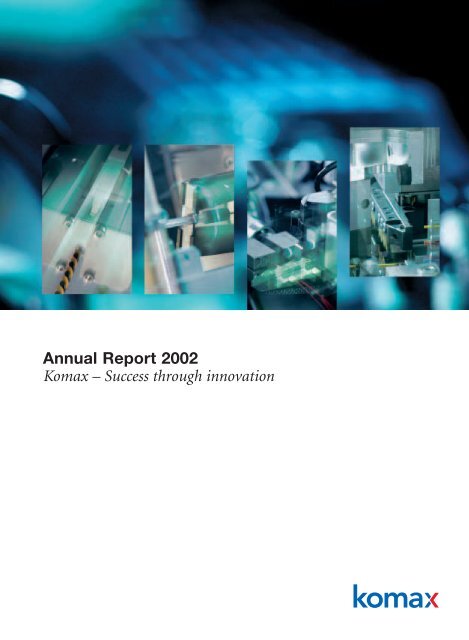
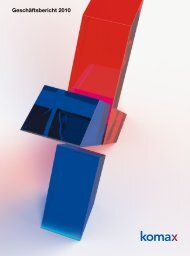

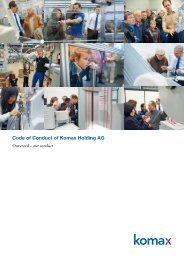
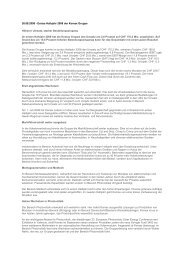
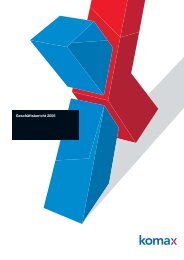
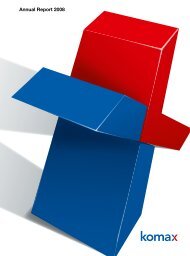

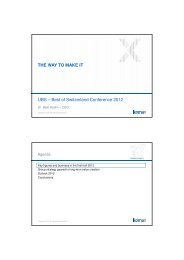
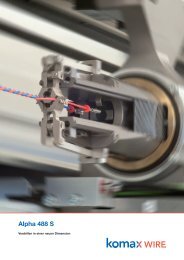
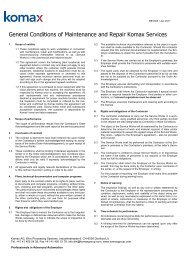
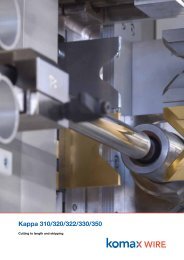
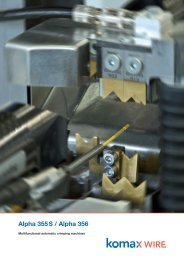

![[PDF] bt 712 - Komax Group](https://img.yumpu.com/9969024/1/184x260/pdf-bt-712-komax-group.jpg?quality=85)
![[PDF] mci 765 C - Komax Group](https://img.yumpu.com/9969021/1/184x260/pdf-mci-765-c-komax-group.jpg?quality=85)